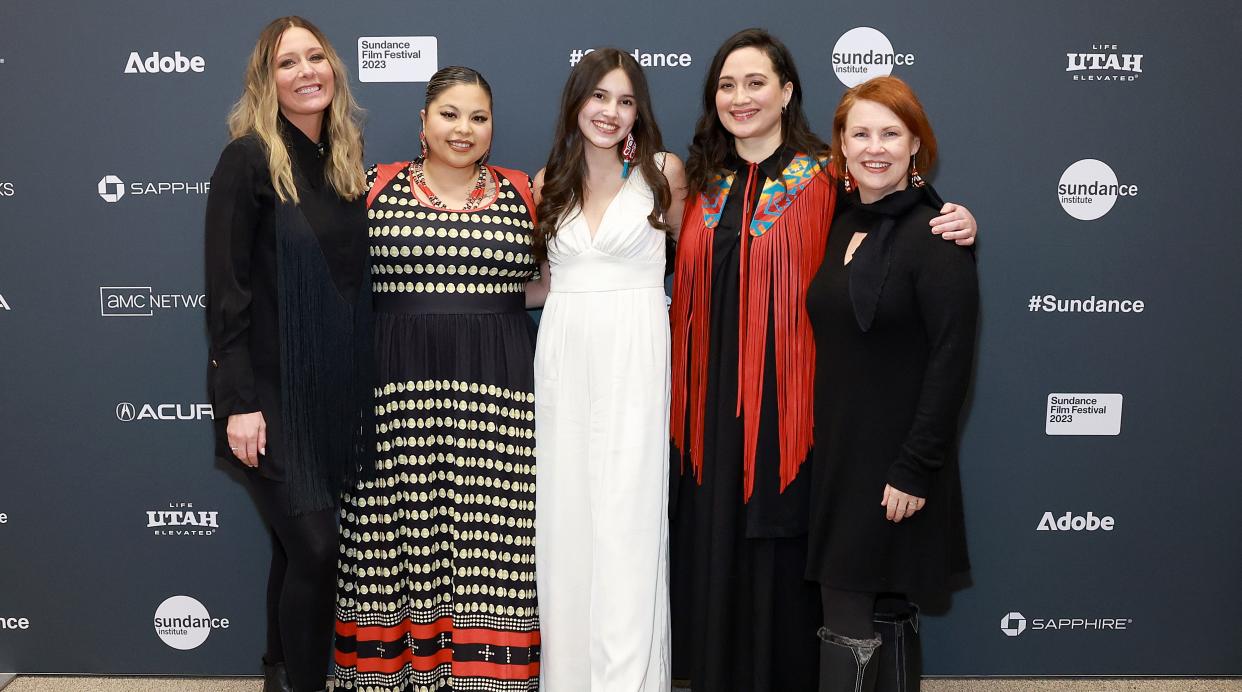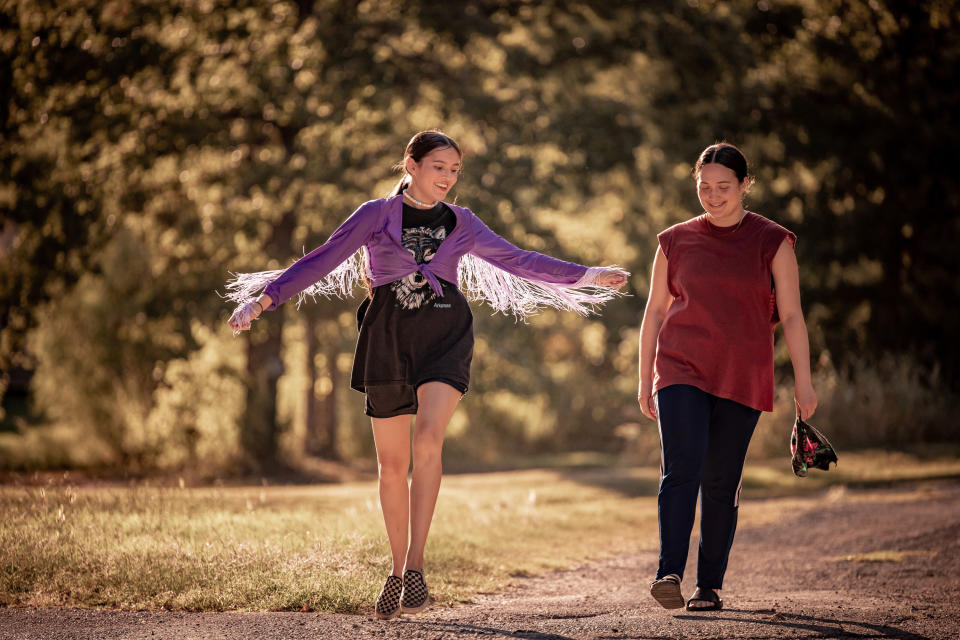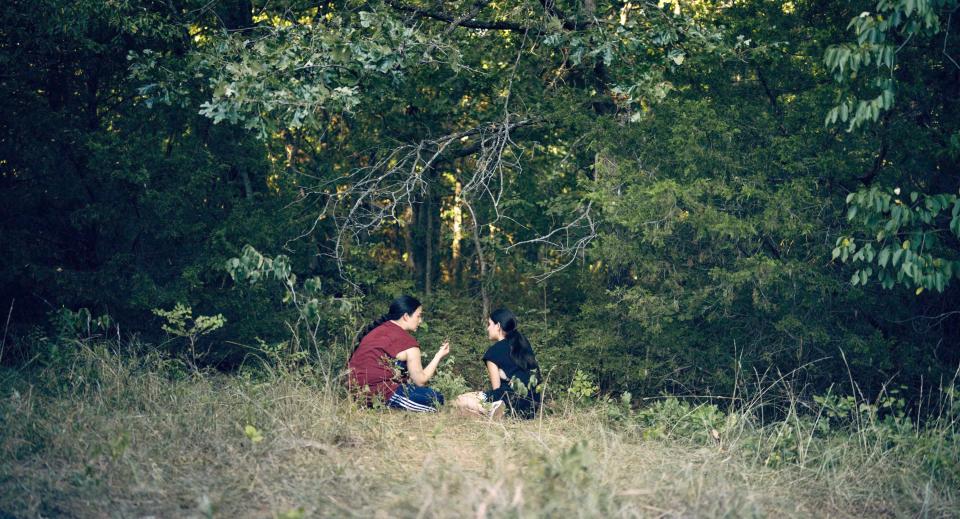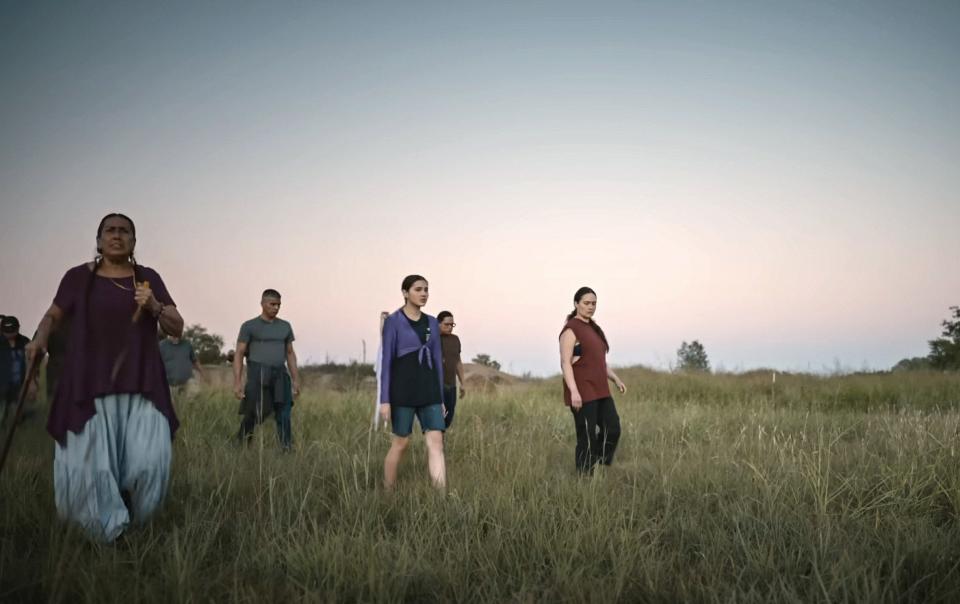‘Fancy Dance’ Star Lily Gladstone and Filmmaker Erica Tremblay Aim High: They Want Film to Join the ‘Canon of Native American Classics’

When it comes to the creative partnership of writer/director Erica Tremblay (“Reservation Dogs”) and Oscar-nominated actor Lily Gladstone (“Killers of the Flower Moon”) — two Native American artists from the Seneca-Cayuga Nation and Blackfeet Nation, respectively — it all started with Tremblay’s Sundance-premiering short, “Little Chief” (2020), inspired by Tremblay’s mother, Sharon.
“I shot it at the school in my community where my mom taught for many years,” Tremblay recently told IndieWire, in a joint interview with Gladstone. “That story felt like a love letter to my mom, and I was drawn to telling more stories about women like Sharon.”
More from IndieWire
That longing birthed the idea of Jax, one of the central heroines of “Fancy Dance,” Tremblay’s confident and powerful narrative feature debut that premiered in Sundance last year and recently found a distribution home at Apple TV+; landing that distribution deal had much to do with Gladstone’s own advocacy for the project while on the late-2023 “Killers of the Flower Moon” awards trail.
“Fancy Dance” follows Jax (Gladstone) and her niece Roki (newcomer Isabel DeRoy-Olson), whom Jax has been caring for since Roki’s mom Tawi had disappeared. Circumstances place the tightknit duo on a road trip through which they investigate Tawi’s disappearance around Oklahoma and make their way to the Reservation’s annual Pow Wow as a pair of runaways bonding around their shared experiences with their family, womanhood, and Native identity.
A key element that led Tremblay to the film’s story was Cayuga itself, an endangered language Tremblay didn’t grow up with but was thoroughly immersed in through a three-year study in Six Nations, Ontario, while also writing “Fancy Dance.” She remembered, “I was studying Cayuga eight hours a day, and then writing at night. We were learning familial words. So I learned that the word for mother is knó:ha and the word for auntie is knohá:ah, which means ‘little mother.’ I was just so inspired to make Jax a little mother. And I saw the image of them dancing together at the end.”
The following interview has been edited and condensed for clarity.
IndieWire: Can you tell me more about the process of immersing yourselves in the Cayuga language and using it in the film?
Erica Tremblay: Currently, there are less than 20 first language speakers of Caguya left, which means that the language is nearly extinct. But there’s this really beautiful revitalization movement happening to save the language. And it was very important for us to get the language correct in the film. I was lucky enough to be a part of an eight-person cohort during this three-year program.
One of the women that was in my cohort, Keysa Parker, came on board to help translate the script. We translated set calls: action, cut, and sound speeds, so the crew was also using Cayuga. It was really this beautiful moment where Cayuga was being used in a modern setting by young people. I’m not a teacher but I am a filmmaker, so I can do my part to showcase the language. Now, Cayuga will be heard in over a hundred countries, which is mind-blowing.

Lily Gladstone: Before my career took an angle into film, I was finding ways to continue acting in social justice circles. And one thing that always really piqued my interest came from Augusto Boal’s “Theater of the Oppressed.” That pedagogy of theater is developing stories with communities that share a common oppression and then creating stories to address it, to imagine the world as they wish it were. It’s a beautiful intersection of arts and activism.
Indigenous languages are spoken languages. They hold our stories, they hold our ceremonies, our traditions. They’re very performative. They’re very descriptive. I always suspected that performance as pedagogy for language revitalization gives the speaker and the learner a chance to express the language in an emotional way. [In order to] think in the language, you have to really know what you’re saying. It’s different than just resuscitation, of just learning and then repeating and reciting in a very contained way. And I’ve always found that when I have to speak in another language or learn another language, if I’m expressing emotion in that line, the line is going to stick. And it also instills the irreplaceability of Jax and Roki’s life. Jax is not perfect, but she is giving her niece something nobody else can at that point. And part of that is the language.
Meanwhile, Cayuga is not my language. Phonemes and morphemes are similar enough to Blackfeet that it was a faster process picking up Cayuga for me than it was Osage [for “Killers of the Flower Moon”]. Same glottal stops, same consonants, a lot of the same vowels. There’s an Algonquin base that our languages share.
Language also shapes the way we see and engage with the world. Knowing that the word aunt means “little mother,” I wonder if the language also informed the film’s unmistakably matriarchal disposition.
Tremblay: Absolutely. As an adult, while I was studying the language, it broke open a whole new relationship to my ancestors, to what the Northeastern of the United States looked like just a short 500 years ago, a blip in human history. For example, if you don’t know the gender of a person, you refer to them as a she. If it’s a group, they’re all shes. And one of the translations for the word chief is, “She holds him by the horns.” Essentially, it is the opposite of the way English is set up to be so patriarchal. We pass resources and land through the women’s clan, which is the exact opposite of how we do things here. And when you’re born into the world, you take your mother’s name. I absolutely was inspired by all of those things.
I wanted to reflect on the importance of matrilineal kinship and relationships between women in a modern-day setting through these two characters who are still surviving an ongoing onslaught of genocide. I was really inspired to imagine what Jax would be doing 500 years ago. And then time-traveling her through all of these complicated geopolitical nightmares and landing her in northeastern Oklahoma in 2024, and asking the question, “OK, what would you do now with this child?”
Gladstone: It’s similar in Cayuga and Blackfeet — they don’t divide familial relationships. There’s not a word for second cousin once removed or even auntie, uncle. All of them are variations of mother, father, and so on. I think of my cousins as my brothers. I feel like a lot of cultures will resonate with that closeness, that sense of family being so tightly knit. Our languages have always acknowledged that humanity of familial relationships against the age-old tactic of entities using divide and conquer.
Part of that was recognized in the assimilation policy of eradicating native language because that eradicates worldview, starts severing those family ties and creates this idea of nuclear family units, dividing community, creating this separation. And that does favor the landholding male. Our language holds space for a lot of things that colonizing bodies do not like, gender expression being one of them, and roles in society, a sense of self in relation to a community. So I think by instilling that language and showing that that’s the heart of the closeness between Jax and Roki is a decolonial act.
Roki feels safe communicating in the language, expresses how she feels as a young woman coming into her womanhood. There’s no space in the language for shame around your period, the way there is in western society. It’s a celebrated thing. And that’s true of so many indigenous languages. Language revitalization is not saving lists of words and phrases. It’s saving a worldview that binds us, that makes us stronger, that serves the perpetuity of our cultures. It’s the root of cultural survival and human survival.
Isabel DeRoy-Olson is terrific in the movie. What did it take to build the closeness we see between Jax and Roki in the film?
Gladstone: I sure felt seen when Erica found Isabel. I’d never met her. We didn’t Zoom or have any chemistry read. We met in the production office, in our first dance class, in our first language classes. One of my earliest mentors said that 90 percent of a director’s job is casting, and Erica’s already such an effortless writer and knows how to lift her words into a moving image. So casting is just a natural extension of that.
She had such a clear idea of who she needed to be. She already knew who I was. She was like, “I really feel like you two will play well together. You look like you could be in the same family.” When Isabel and I had just our first interaction, we noticed that we would speak with the same cadence a lot of the time.
We both have a ballet background. And in our two different styles of fancy dance, we had a lot of the same impulses as former ballerinas. In the “stealing the gas” scene, I couldn’t see Isabel on the other side of the pump. She couldn’t see me. But then when you watch it later, we’re moving at the exact same pace, and it looks like a choreographed piece that we just did. Erica found my niece in the real world, and then she got to play my niece in a created world. [To Tremblay]: You can take credit for all of that.

Tremblay: I always say that if I accomplished nothing else with this film, it was bringing Lily and Isabel together, because they have such a beautiful friendship. It was wonderful to see them bonding during our prep time. Their chemistry on screen was rooted in their relationship and their curiosity with each other.
One of my favorite things about “Fancy Dance” is how much it feels like a classic film, recalling the types of road movies and thrillers I love, but with characters we didn’t necessarily see leading those genres.
Tremblay: I was raised without cable most of my life. And I had two ways of seeing the moving image. One was mom would let us go up to the video store, and we could rent three or four movies per week from the 50-cent bin. And they were all black-and-white movies. So I was raised watching all of the old Shirley Temple movies, and incredible black and white films of Hitchcock. It was just a treasure trove of classics that I was allowed to have just because it was what was affordable. I have just always been really inspired by those old classic films and their humor — the way they would take on serious topics, but there would need to be humor. And I fell in love with Danny Kaye.
Then, the other way I got to watch moving images was [that] I had a family member who would record 90 minutes (because that’s how much you could fit on a VHS tape) of MTV at a time and mail it to us. But it would just randomly be whatever 90 minutes happened to be on when they would leave the house. And so sometimes it would be the Heavy Metal show, or the Top 20 Countdown. And I fell in love with music videos. Back in the ‘90s, those were epic tales with beautifully complicated stories, but with no dialogue.
And I challenge myself in scenes when I’m writing and directing: How can I tell this story, get it as far along as possible without anyone saying anything? There are so many films that [co-writer] Miciana [Alise] and I referred to while we were making this: “Thelma & Louise,” “Winter’s Bone,” “Paper Moon,” and “The Florida Project.” I don’t think we thought about genre. We just had a story in mind of an aunt and a niece getting to [do] a Pow Wow and dancing together.
You can see it also in the show “Reservation Dogs,” which I also worked on: We are a blend of genres. We walk through the world as indigenous people laughing with each other, making jokes with each other, surviving an ongoing onslaught of oppression that exists in our communities. We are blending genres as we move around in the world.
And speaking of older movies, I couldn’t help but notice the “Dances with Wolves” VHS tape in an early scene in the film, in a blink-and-you-miss-it scene. What’s the story there?
Tremblay: That wasn’t written into the script, but that’s such a beautiful moment our set designer and production designer [added]. When it showed up, I remember there was this flurry of research that producers were doing to make sure that we could show it. The spine had to be up a certain way, and it couldn’t be touched. “Dances with Wolves” was the kind of movie that we would watch over and over as kids.
Gladstone: It was a new revisionist Western that was different. It was the first time you see Lakota language spoken intimately.
Tremblay: My hope and my goal now is, 20 years from now, I hope “Fancy Dance” is the spine of someone’s drawer that they open and that “Fancy Dance” can enter the canon of Native American classics.
Their stories might be a century apart, but it’s startling how linked the themes of “Killers of the Flower Moon” and “Fancy Dance” are. Lily, were you thinking of these projects in proximity? Were Mollie from “Killers” and Jax in conversation with each other for you?
Gladstone: They are both sisters mourning their missing sister. Same land, a hundred years later. They are very different women in very different points in history, but it’s a continuation of the same old story. “Killers of the Flower Moon,” in a lot of ways, prepped a broader audience to want to see our beautiful, lived-in indie.
People who were seeing “Fancy Dance” in festivals knew how great it was. But we’re still battling a lot of things that a lot of filmmakers from marginalized communities do. You have this pressure to create these model minorities, perfect victims that an audience will want to engage with. There’s no moral conflict [in those stories]. And it’s clearly not reality. Human beings are complicated and flawed, they are products of their environment. We kind of got saddled with that in the way that “Thelma & Louise” and “Paper Moon” never would’ve been. But I just hoped that when “Killers of the Flower Moon” came out, people would connect with the heart of that story, which is its Indigenous women.

That film allowed audiences an opportunity that rarely exists in a film of that magnitude, to really fall in love with an indigenous woman, to care about her wellbeing, to care about her grief. I was, of course, receiving the feedback from the Mollie side of things, and people wanted more of her. People wanted more of her sisters, more of her mom. They wanted more Osage. My mom went to a Q&A screening for “Fancy Dance,” and she said there was a young man in his early 20S who stood up AND talked about how much he loved film and how much he loved Scorsese and “Killers of the Flower Moon”. And then mentioned everything that he wanted more of from “Killers” was in “Fancy Dance,” and he really hoped audiences had the chance to see both together.
People in our communities who have the rights to our stories, who are storytellers, oftentimes will not tell stories alone in a vacuum. Two are told at the same time because they contextualize each other and they prop each other up. You need one to really understand the other. So I’m really grateful that these two are now linked in the way that they are.
While the backdrop of this movie is the devastating “Missing and Murdered Indigenous People” epidemic, I really do feel you intentionally didn’t tell a doom-and-gloom story. And those stories, in different hands, sometimes feel exploitative.
Tremblay: One of the things that really rubs me the wrong way as a person who’s a Native American is, when people find that out about me, there’s this immediate response of pity. “Oh, you just grew up in poverty.” I’ve always been just totally irked by this assumption of what a native reservation is like.
At some point, I started questioning, what do you think happens in a trailer park? What do you think happens in a HUD house? And the kind of way that natives have been represented and that poverty is represented is just not what it really is like. People watch TV in trailers, fight with their mom, they have sex with their boyfriends, they eat dinner, they live beautiful whole lives. And on reservations, there are people who are in some kinds of homes, and there are people who are in other kinds of homes.
In my lifetime, I’ve gotten to live in both sides of it and experience what it was like to not have anything. And then what it was like to have a stepdad and a nice house. [In “Fancy Dance”], we took great care to pick the home that they live in, which is a very traditionally built HUD house, which you can see on reservations across the country. I wanted to see the joy behind the door because in so many films that represent Native Americans, you see a white savior cop solving a murder, and you see one little slice of life from inside of the door as they ask a family member a question. And it is doom and gloom. And there is no humanity applied to these people.
So mining their trauma just exploits them for a story that services a white character. For Miciana and I, we were going into our community. We’re going into homes to show the quilts hanging on the wall, the care with which they take care of each other and their belongings. Maybe they’re eating saltines and butter for dinner, but by God, they’re doing it together and they’re speaking their language together. And it is joyful and it is joyous. And the only way that you can survive the onslaught of oppression and MMIP and forced removal is to laugh and to feel the human connection, to experience joy together.
At end of the film, where these two beautiful indigenous women are suspended in the air dancing together for those who cannot dance, you hopefully feel the humanity of these two characters. And you find a way to make a bridge to those indigenous neighbors in your community that you can help uplift.
AppleTV+ will release “Fancy Dance” in limited theaters on Friday, June 21, ahead of its Apple TV+ launch on Friday, June 28.
Best of IndieWire
The Best Father and Son Films: 'The Tree of Life,' 'The Lion King,' 'Nowhere Special,' and More
The 51 Best Sexy Movies of the 21st Century, from 'Spring Breakers' to 'X'
The 14 Best Thrillers Streaming on Netflix in June, from 'Fair Play' to 'Emily the Criminal'
Sign up for Indiewire's Newsletter. For the latest news, follow us on Facebook, Twitter, and Instagram.

 Yahoo News
Yahoo News 
